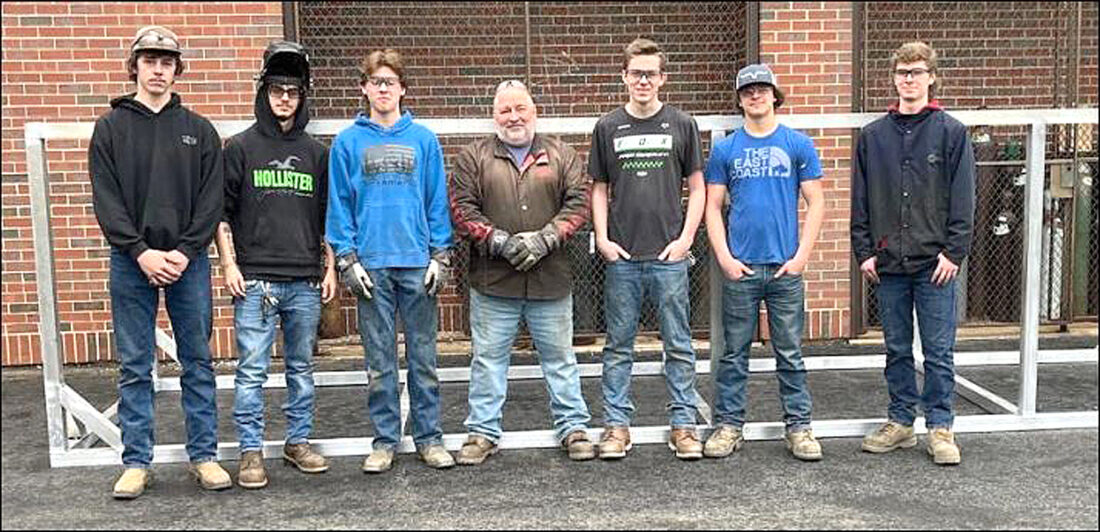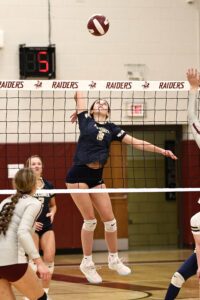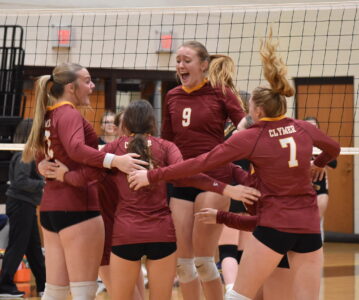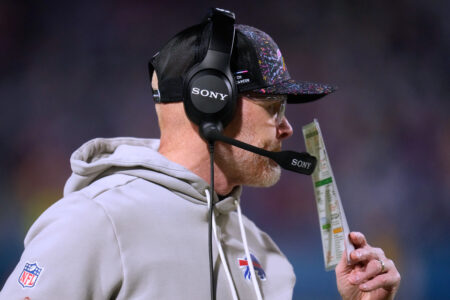Trout Pen Project For Dunkirk Harbor

Last year, students in the Niagara/Orleans BOCES welding program designed and fabricated new aluminum fish pens (behind the students) to replace degraded steel pens for Eighteenmile Creek/Lake Ontario. Photo courtesy of Niagara/Orleans BOCES
The pen rearing of trout is a proven process to promote the healthy growth and development of young fish before releasing them into the wild. The Northern Chautauqua Conservation Club — aka Con Club — is stepping up to discuss details of a project plan to build and manage fish pens in Dunkirk Harbor. They are seeking ideas, volunteers and potential funding to support the eventual process. A meeting is planned for the club at 6 p.m. Oct. 22, and is open to members and visitors alike. The club is located at 1 North Mullet St. in Dunkirk (716-366-8836).
Similar pen-rearing programs exist in several places across New York. Among them are the Bison City Rod and Gun Club on the Buffalo River, and multiple other sites along the Lower Niagara River and Lake Ontario, where steelhead trout and Chinook salmon are pen-reared every spring. It all started in 2004 with an idea from the Lake Ontario Trout and Salmon Association, with help from the Niagara River Anglers Association and the New York Department of Environmental Conservation.
The Lake Ontario-related pen-rearing projects have grown from two pens and 20,000 fish to nine pens and 153,000 fish in 21 years.
Technical support sources for pen-rearing projects in New York come from the DEC, which provides fish from the hatchery system, technical oversight, and often partners on logistics. Recent DEC initiatives and hatchery investments demonstrate the state’s support for rearing/stocking. Federal partners/grants (such as USFWS and Sport Fish Restoration/Dingell-Johnson funds) can occasionally be coordinated with USFWS and federal conservation grant programs to provide support for collaborative projects. State agencies commonly leverage federal sport-fish grants. The local conservation clubs typically supply volunteer labor, local fundraising and sometimes in-kind services (boat access, pen construction, etc.). In the past, marinas have hosted pen placements, and local governments or tourism/economic development groups often support such projects. Why? Because the fishery supports the local economy. Private donors, too, occasionally contribute cash or in-kind support (dock space, cranes, storage). The potential impact of the project on the local economy is significant, offering hope and optimism for the community.
Last year in Medina, students in the welding program at the Orleans Career and Technical Education Center worked on constructing a fish pen for the Eighteen Mile Creek Pen Rearing Project with oversight from the Lake Ontario Trout and Salmon Association. The class created all-aluminum fish pens to replace degraded galvanized steel pens, allowing their pen-rearing program to continue for many years to come. What an outstanding student contribution that included the design and fabrication of the new pens. Funding for that project was provided through the Sport Fish Restoration Program, which provides funds to fish and wildlife agencies of the states, the District of Columbia, and U.S. territories for fishery projects, boating access, and aquatic education. The program was created in 1950, with the passing of the Sport Fish Restoration Act (the Dingell-Johnson Act). Modeled after the successful Wildlife Restoration Act, the Sport Fish Restoration Act dedicated permanent funding for fishery conservation.
In the fish pen project history of steelhead fingerlings/yearlings, fish pens can expect a few thousand up to 15,000 fish per pen/project, depending on pen volume, fish size (fingerling vs yearling), and partner capacity. Smaller volunteer projects often hold low thousands; larger marina/club projects may hold >10k. Fish size matters — smaller fingerlings allow higher counts per pen; DEC/LOTSA reports include fish-per-pound metrics (e.g., steelhead ~14 fish/lb) that help estimate biomass and pen loading. One goal of the fish pens is scent imprinting, holding the fish for several weeks to encourage their adult return to the area.
With help from the DEC regional fisheries staff, the Northern Chautauqua Conservation Club will learn about the details of any required permits and related oversight regarding the pen size and fish size. Then, there is the need to line up partners, volunteers, and funding, or complete applications for monetary support. It’s exciting! Hats off to the Con Club. Join the fun.
Gotta love the outdoors.
CALENDAR
Oct. 11 to Nov. 2: NYS Western Zone hunting season for ducks and coots. See syllabus. For bag limits/rules.
Oct. 16: Opening day of NYS inland trout catch and release season.
Oct. 16: Southtowns Walleye Association, monthly meeting, 7 p.m., 5895 Southwestern Blvd., Hamburg.
Oct. 16: Lake Erie Chapter of Fly Fishers International, monthly meeting, fly tying 6 p.m., meeting 7 p.m. — steelhead fishing in local streams with local experts; Burchfield Nature and Arts Center, 2002 Union Road, West Seneca.
Oct. 18: NYS Western Zone pheasant season opens. Season ends Feb. 28, 2026. See syllabus for bag limits, etc.
Oct. 18: NYS Southern Zone turkey season opens, sunrise to sunset, season bag limit: one bird either sex, ends Oct. 31.
Oct. 22: Fish Pen Project meeting, 6 p.m., Northern Chautauqua Conservation Club, 1 N. Mullet St., Dunkirk; looking for volunteer helpers.



